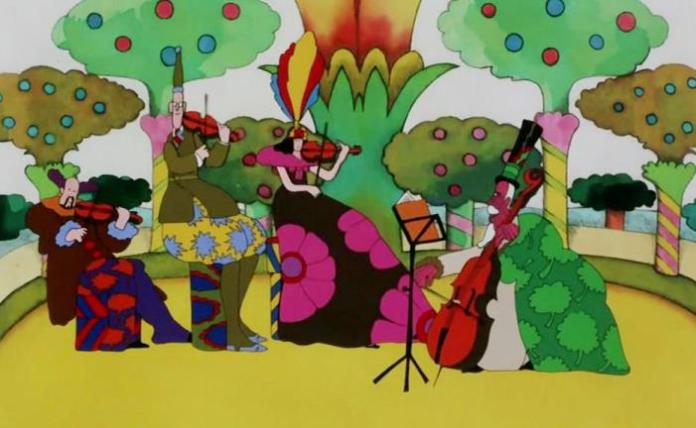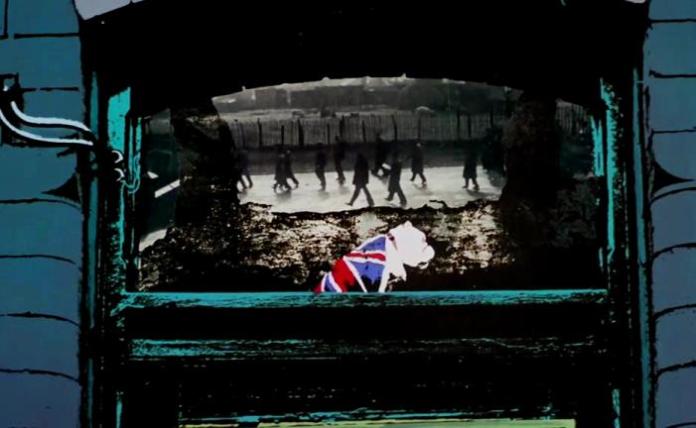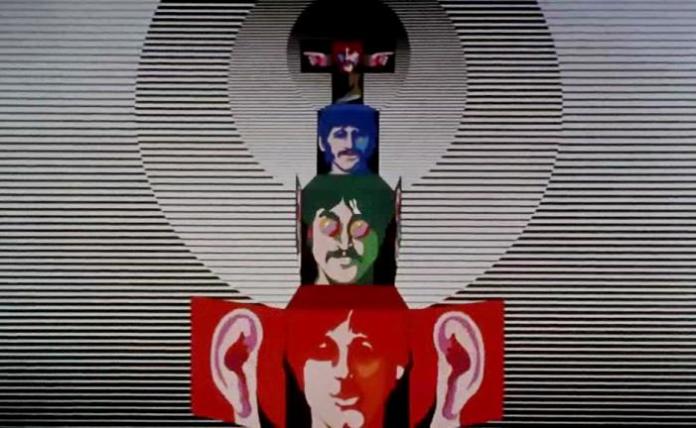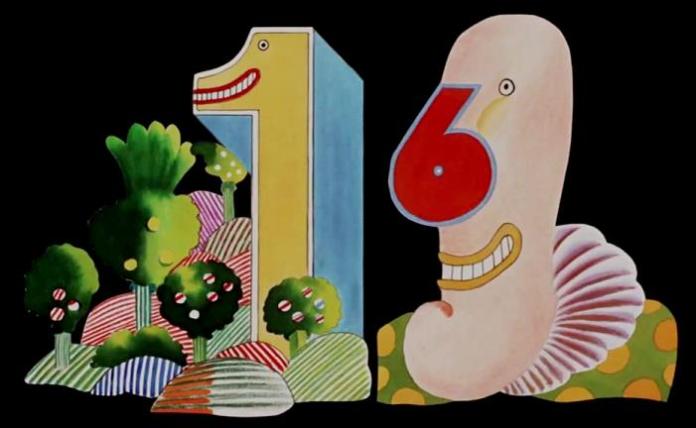.

.
Director: George Dunning
By Roderick Heath
Amidst the relics of the high psychedelic era, Yellow Submarine is one of the most instantly recognisable, a jokey and absurdist adventure tale built around one of pop culture’s singular creative wellsprings, the music and artistic personae of The Beatles. The film has become an iconic work encapsulating the Beatles’ oeuvre and mystique and indeed the era of its making. Any still from the film could be used as an emblem and summation of the psychedelic creed. Ironically, Yellow Submarine was a byproduct of the band’s uninterest in appearing in another film: their contractual obligation to United Artists forced them to develop a new movie project, and they decided producing an animated film through their newly formed recording and production company, Apple, seemed a good way to discharge the obligation. (Later, UA eventually declared they hadn’t met that obligation, requiring them to make the 1970 documentary Let It Be.)
.

.
I was moved to revisit Yellow Submarine in part because of the passing of Sir George Martin, the Beatles’ illustrious producer and facilitator. Martin, as well as helping to create the Beatles songs heard on the film’s soundtrack, also composed the orchestral score that gives the movie some of its gorgeous, jaunty, romantic gloss. John Lennon, Paul McCartney, George Harrison, and Ringo Starr kept their distance from the project, which was handled by George Dunning, an animator who had a lot of experience working on a playful, animated children’s show about the band that ran during the second half of the ’60s. The film Dunning was assigned was something very different in concept and style, and only when the film was nearing the end of production did the band members realise something marvellous had been created. Nonetheless, their creative lexicon was key to the vision Dunning and his animation team realised, which extrapolates images and ideas from their songs, as well as builds sequences for their music to play over to create a uniquely textured film.
.

.
Considering that animation opens up to filmmakers a form of expression seemingly without limits, most animated features are amazingly conservative, mainly tethered to realistic precepts and slight fantasies meant for kids. If you look at a recent, lauded, smart, but very anodyne kind of animated film, Inside Out (2015), you can see very similar ideas to those in Yellow Submarine, but bound by neat chains of cause and effect in painting the workings of the psyche in total contradiction to the protean delights of the surrealist wellspring both films reference. Yellow Submarine takes its title and core imagery from one of the most deliberately lightweight, yet naggingly catchy tunes Lennon and McCartney ever wrote, a burlesque-cum-tribute to singalong shanties of the Liverpool docklands surely familiar to any son of that port city, given a new paint job in hallucinogenic hues. In Dunning’s film, thanks to a screenplay penned by a small battery of writers, including original story scribe Al Brodax and future Love Story hitmaker Erich Segal, that jaunty number becomes the basis of an oddball, highly unserious take on a Tolkienesque fantasy quest tale. It starts off in a magical kingdom called Pepperland, where free and easy creativity and benign good cheer reign, only to be targeted by an army of nasty creatures called the Blue Meanies who, with their henchmen, want to destroy this last corner of the nonblue universe.
.

.
Pepperland is reminiscent of an Edwardian bohemian fantasia of polite relaxation and gentlemanly recline, where the mayor of the town plays in a string quartet and the champions of the land are a foursome of bardic heroes called, inevitably, Sgt. Pepper’s Lonely Hearts Club Band. The invasion of the Blue Meanies, led by a chief (voiced by Paul Angelis, who also does voice work for Ringo and George) who declares angrily to his underling, Max, that Blue Meanies never take “yes” for an answer owing to their dedicated negativity. Their invading army includes a huge, flying glove and shock troops who bonk enemies with giant green apples (making sport of the symbol of the Beatles’ own label). Their bombardments petrify the inhabitants of Pepperland. One citizen, Fred (Lance Percival) is an old man (although the mayor is so ancient he calls him “Young Fred”) who wears a sailor suit but has no actual naval knowledge whom the mayor assigns the task of taking the Yellow Submarine, the vehicle that first brought Pepper’s band to the land, out into the world to find help. His search brings him to a street in Liverpool where Ringo, kicking about the streets bored and frustrated, senses he’s being followed and tries to get the attention of a policeman who’s too absorbed in trying to charm a cat. Finally, Ringo heads back to The Pier, the house he shares with the other band members, and Fred pops out of the submarine to make his appeal for aid, recounting the attack and his adventures in a babbling torrent.
.

.
Yellow Submarine blends many of the contradictory imaginative and cultural reflexes that nestled close to the Beatles’ hearts and energised their art—a faith in electrifying vision and a frontierlike sense of art as a vehicle for life, jostling against a wistful nostalgia for half-remembered ages and semi-mythical qualities of bygone days. The first post-credits sequence, built around “Eleanor Rigby,” envisions decaying industrial Britain through the detritus of its own cultural memory, a monochromatic space populated by figures that appear culled from historical photographs, illustrations, and other bricoleur discoveries, with the jutting, grimy chimneys of the city’s rowed terraces suddenly exhaling like ship’s horns. The sequence doesn’t illustrate the song’s tragic narrative, but underscores its evocation of a blasted, lovelorn corner of the world. Spots of colour, like the Union Jack waistcoat on a very British bulldog overlooking the scene, the periscopes of Fred’s lurking submarine, or the butterfly wings jutting from the back of a meditating philosopher, appear as islets of bliss and invention amidst a landscape dominated by characters who try to do things—footballers warming up on a field, a man trying to get out of a phone booth, a motorcyclist with an anarchic swath of regalia on his helmet but tears leaking from his eyes—but whose motions simply loop. Here the artistic influences hew close to the effects of pop art, particularly Warhol’s obsession with silk-screen derivations of photos and utilising collected, pasted-together images. The images coalesce to evoke a kind of dream-memory in the British psyche where it’s always a chill and depressing day in 1931. The air of melancholy stasis and the soul-grinding side of this dream-memory is countered with images of absurdity and florid mind-over-matter invention as Fred follows Ringo home, who immediately turns the sorrow of the song into theatricality as he laments that “compared to my life, Eleanor Rigby’s was a gay mad whirl.”
.

.
The motifs here reproduce those already well established in Richard Lester’s two films featuring the band, depicting the musical foursome as founts of inspiring anarchy in a dreary and clapped-out world. Lester presented a gag in Help! (1965) where the band members arrived at their homes adjoining terrace houses in the midst of Liverpool, only to reveal spacious, conjoined, luxurious environs within. Here Dunning and his animators take that gag a step further and portray the interior of The Pier as a cavernous expanse that blends a Borgesian dream-labyrinth with Looney Tunes gagsmithing; Fred enters the house and disappears through one of hundreds of ranked, identical doors, as behind his back flit fairytale characters, id creatures, and icons out of Dadaist art. The influence of Spike Milligan’s The Goon Show, a radio programme that left a powerful imprint on Lennon and many other British talents of his generation, including the Monty Python squad, is in constant evidence in both the stock characters and the random jokes, including George’s refrain of “It’s all in the mind”.
.

.
Fred manages to interest Ringo in his incomprehensible pleas, and they round up the other members of the band, each of whom is glimpsed retreating in some bubble of their own self-perception in a house littered with psychitecture zones adapted to their personalities. Ringo drives a vintage sports car down a grand art-deco staircase. John (John Clive) is first seen in a room littered with pop culture iconography, managing to be both Frankenstein and his own monster as he lurches off a laboratory table as a stitched-up hulk before swallowing a potion to shock himself back into normal state. George stands atop a psychedelic mountain riddled with portals into other realities, communing with the sky–although he’s also in two places at once, the mystic strains of the sitar ringing out all the while. Paul (Geoff Hughes) emerges from his rooms dressed as a strutting dandy to a round of orgiastic applause.
.

.
The lads quickly agree, in confused fashion, to join Fred in his quest to retake Pepperland, and they depart in the submarine. “Right, then, let’s get this vessel shipshape,” Fred commands happily, to Ringo’s droning dissent, “I kind of like the way it is—submarine-shape.” Their journey to Pepperland is chiefly an excuse to string together a succession of weird places, each of which is associated with a different artistic style and Beatles song. Yellow Submarine is encyclopaedic in the breadth of its references and appropriations, a freeform surge of artistic modes culled from art nouveau, art deco, fauvism, op art, cubism, comic book art and children’s book illustrations. Filmic technique runs from classic animation to rotoscoping (particularly during a sequence of dancing girls matched to “Lucy in the Sky with Diamonds”), whilst the submarine’s departure on its journey back to Pepperland is portrayed in a stroboscopic array of photos set to the famous rising, atonal crescendo from the finale of “A Day in the Life.” Through it all runs a streak of comedy that alternates total surrealism and visionary largesse on the visual level—trains racing out of rooms and halted by a slamming door, a colossal monster that sucks in anything in its path through a giant nozzlelike nose, a hole that can be folded up and kept in a pocket for later use—and verbal humour that runs in an opposite vein, replete with throwaway, non sequitur, sarcastic deflations wielded by the Liverpudlian heroes used to negotiate all kinds of bizarre situations and scarcely fazed by time warps, flying neon piranha, and trotting monsters in Wellington boots.
.

.
It’s rather beside the point to critique Yellow Submarine on a narrative level, although the story holds together in its own, specific, shaggy way. The film acts more like a total immersion in a way of seeing the world, inflected by two seemingly opposite terms of reference. It’s both a sophisticated arrangement of artistic modes, metaphors, and mythic motifs that rarely pauses for the slow members of the class to catch up, but also a deft approximation of a childlike sensibility, a place of multitudinous colours, transforming beings, and amorphous possibility seeking joy in the universe, boiling down to a simple message: all you need is love. This suits the band’s peculiar grip on the pop culture zeitgeist at the time, one sustained by their ready ability to shift their official personas slightly to become something different, depending on the angle from which they were viewed: as happy-go-lucky types living something close to a kid’s ideal of what adult life might be like, as counterculture swashbucklers deriving world-shaping ideas from exotic religions and pharmaceutical enhancements, as roguish bon vivants and barely reformed likely lads out of Liverpool with a pleasant line of blarney just out for a good time, or as the moment’s manifestation of an ancient force, the eternal troubadours, bringers of colour and life, with a dash of messianic messaging.
.

.
All of these facets are present in the film, which amplifies a central joke from the famous cover of the Sgt. Pepper’s album, where the Beatles are presented in the guise of the fake band with their own, earlier, canonical selves standing next to them. Here the Beatles are required, once they reach Pepperland, to pretend to be Sgt. Pepper and his band to step into the ancient and foundational role of the land of pure imagination. To get to that pure land, they have to travel through places of fragmented nature, places where strange animals roam, where time becomes a fluid entity, where the usually invisible geometries of scientific law suddenly become manifest, sound and vision can be interchangeable, and even the absence of form itself can be entered and contended with on the way to shaping a world. Along the way, the band members and Fred have to contend with an engine that breaks down, Ringo being carried off on the back of a bizarre animal, an attack by Indians requiring a secret weapon consisting of a fully bedecked cavalry unit to be loosed by the submarine, the great horn-nosed monster sucking everything including itself into a white void known as the Sea of Nothing, and getting caught in a time eddy where the submarine’s crew rapidly age both backwards and forwards and catch sight of themselves on the way around.
.

.
There are strong affinities between Yellow Submarine and the same year’s science fiction treatment of many of the same themes in Stanley Kubrick’s 2001: A Space Odyssey, sporting adventurers who journey through a dazzling, trippy-coloured acausal portal through different zones of reality, contending with zones of the Einsteinian universe where time breaks down and they’re old and young at once, and are eventually confronted in the void by a singular being who represents the psyche in all its multifarious, ridiculous aspects. Tonally, of course, they’re completely opposed: Kubrick’s deadly serious contemplation of the transcendent urge via a blend of hard tech and soft psychedelia is viewed in the funhouse mirror here, as the other Beatles give smirks and groans of boredom when John starts extemporising on theoretical physics in the midst of a rupturing watercolour world that embodies the elusive freedom of the psyche’s brighter frontier. Meanwhile, during the Sea of Time sequence, Paul leads the lads in a performance of “When I’m 64” whilst they’re sprouting long, white beards, whilst on screen the animators try to illustrate the possibilities inherent in a mere minute of time, counting off the seconds with elaborately illustrated numbers, a jokey version of the same idea presented with a more fearsome and clammy attitude in another film of the same year, Ingmar Bergman’s Hour of the Wolf. In the Sea of Science, scored by the draggy, druggy, glittering sounds of “It’s Only a Northern Song,” the film skirts total dissolution into abstraction, where the film’s soundtrack becomes an animated squiggle and our heroes spin around in convoluted geometries.
.

.
In the Sea of Nothing, the submariners encounter a weird being with a hairy, dextrous body and a face like a Commedia dell’arte mask, who calls himself Jeremy Hillary Boob PhD (or “Phud” as Ringo reads it on his business card), engaged furiously in creativity and learning without any apparent purpose. He’s the embodiment of the hapless hero of “Nowhere Man,” which John leads the band in singing, bringing sworls of colour and form to the void as Jeremy weeps in self-recognition. Jeremy nonetheless starts converting book smarts into real-world practice as he fixes the submarine’s troublesome motor, and Ringo, recognising a fellow misfit, invites Jeremy along on the journey. The submariners then enter what John calls “the foothills of the Headlands,” a place filled with colossal, see-through heads alight with thought-images and coated in a fine dusting of pepper, which when disturbed causes all the big giant heads to sneeze and blow our heroes down a deep pit into the Sea of Holes. There, Jeremy is kidnapped by a stray Blue Meanie, but the Beatles manage to find the way out into Pepperland itself and are soon followed by Fred. They’re greeted by a panorama of petrified Pepperlandians, with Blue Meanies constantly patrolling to refreeze anyone who’s waking up. Told by the mayor they have to stir the populace by pretending to be the Lonely Hearts Club Band, the Beatles sneak into a bandstand surrounded by sleeping Meanies, retrieve their instruments and uniforms, and launch a musical assault on the forces of bad vibes.
.

.
Yellow Submarine purposefully resists, after the “Eleanor Rigby” scene, traversing the more perverse and melancholy aspects of the Beatles’ music, or the darker, more toxic strands to psychedelia captured by other bands essaying the form, like the Thirteenth Floor Elevators, The Nice, and King Crimson. Yellow Submarine is dedicated to being a good trip: even Lennon’s biting self-satire in “Nowhere Man” is given a jolly and positive spin. And yet there is a sneaky, almost subliminal aura of strangeness and distance to the whole project, the style of humour and the textures of the visuals charged with an eliding, cheeky, diminuendoish quality, never quite building to obvious punch lines or the kinds of patronising joke-delivery systems and metaphors too much animated cinema, even the wildly praised Pixar films, still offer. There’s potency to the Blue Meanies as adversaries (my mother, who was 20 when the film came out, still can’t abide them), sibilant, fey and ambisexual in just the wrong manner, the ever-so-faint shudder of the molester’s insidious grinning evil to them, and their oppression of Pepperland, which is at once playful and unpleasant. The bonks of the green apples are comic, but some of the images, like a line of their shock troops, grinning evilly behind dark glasses and giving Nazi salutes, like Peter Sellers’ Dr. Strangelove given a pop makeover, have a charge of lunacy behind them.
.

.
Good triumphs, of course, as a few good licks of “Sgt. Pepper’s Lonely Hearts Club Band” and “All You Need Is Love” shake Pepperland back to life and empower the citizens to chase out the Blue Meanies. The chief Meanie, after seeing his flying glove and multiheaded guard dog defeated, is rendered utterly helpless and humiliated by Jeremy, who causes flowers to break out all over his furry form. This leads to a climax set to Harrison’s “It’s All Too Much,” a triumphant procession of the populace of Pepperland, their saviours, and their defeated, yet accepted, enemies celebrating. Here the film pays its last nod to both the kinds of courtly sagas its narrative resembles, but also the final cast call of the musical traditions it extends. The real Beatles finally make a brief appearance right at the end, showing off their souvenirs of the journey and leading the audience in another of their schoolyard, dittylike numbers “All Together Now,” going out with a last blast of the overall, inclusive idealism Yellow Submarine embodies, the refrain of the song spelt out in a dozen languages. Of course, the love trip went sour by the decade’s end, and this kind of wilful naivete went right out of fashion. But Yellow Submarine’s impact, if not its best lesson, has echoed through animated film after it. And in an age of random terrorist attacks and the seeming willingness of far too many people to buy into the politics and philosophy of hate and resentment, watching a film that preaches acceptance, love, and peace without a drop of sarcasm suddenly feels revolutionary again.

It’s been so many years since I’ve seen this film! I do, however, remember a quickie allusion to Astaire and Rogers dancing to “Night and Day.” Where does that fit in?
LikeLike
I believe that’s during the “Lucy in the Sky With Diamonds” sequence, Chris; a little quick research tells me they’re directly rotoscoped. That sequence is really fun.
LikeLike
Excellent review, Rod! I watched this every few years after seeing it on release and it eventually came out on tape, and it stood up amazingly well, there’s not another film like it, which has been reinforced by showing it to my grandkids, who were bowled over by it. It works on multiple levels, and they see more in it every viewing.
LikeLike
I’m glad your grandkids liked it, Vanwall. It cheers me to know this still has such a strong effect. For myself, I was moved to write this not just to mark the passing of Martin but also because my last viewing of it was on the night of the Brussels attack – I came back from reading about that online and watched the last part of this and the contrast was truly bewildering. And then suddenly watching a film with such a message felt like an act of defiance and fightback.
LikeLike